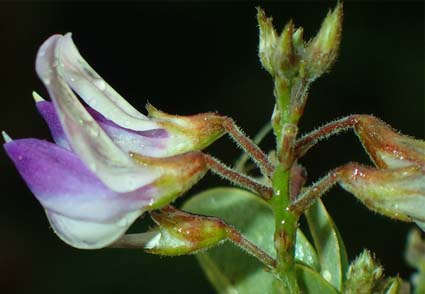Abstract
Campylotropis luquanensis, a new species from Yunnan and Sichuan, Southwest China, is described and illustrated. It is morphologically similar to C. grandifolia and C. henryi, but it can be distinguished by having smaller stipules, abaxially sparsely pubescent obovate to obcordate leaflets, shorter inflorescences, and legume with obvious net-veins. Moreover, C. luquanensis is distinguished by usually with 2–4 axillary racemes densely clustered on the second-year brachyhlasts, and by its flowering before leaves. Information of this new species including distribution, habitat, phenology and etymology is also provided.
References
<p>Bunge, A.A. (1835) Plantarum mongholico-chinensium, decas prima. <em>Uchenya zapiski Imperatorskogo Kazanskogo Universiteta, Kazan</em> 4: 154–180.</p>
<p>Fu, P.Y. (1987) A study of the genus <em>Campylotropis</em> Bunge in China. <em>Bulletin of Botanical Research</em>, Harbin 7: 11–55.</p>
<p>Huang, P.H., Ohashi, H. & Iowaka, Y. (2010) <em>Camyplotropis</em>.<em> In: </em>Wu, Z.Y., Raven, P.H. & Hong, D.Y. (Eds.)<em> Flora of China</em>, vol. 10. Science Press, Beijing & Missouri Botanical Garden Press, St. Louis, pp. 292–302.</p>
<p>Iokawa, Y. & Ohashi, H. (2002) A taxonomic study of <em>Campylotropis</em> (Leguminosae) I. <em>Journal of Japanese Botany</em> 77: 179–222.</p>
<p>Iokawa, Y. & Ohashi, H. (2008) <em>Campylotropis </em>(Leguminosae) of China, an enumeration and distribution. <em>Journal of Japanese Botany </em>83: 36–59.</p>
<p>IUCN (2019) <em>Guidelines for using the IUCN Red List Categories and Criteria, vers. 14</em>. Prepared by the Standards and Petitions Subcommittee of the IUCN Species Survival Commission. Available from: http://www.iucnredlist.org/documents/RedListGuidelines.pdf. (Accessed 21 September 2021).</p>
<p>Michaux, A. (1803) <em>Flora Boreali-Americana</em>, vol. 2. Levrault, Paris, 340 pp.</p>
<p>Ohashi, H., Polhill, R.M. & Shubert, B.G. (1981) Desmodieae.<em> In: </em>Polhill, R.M. & Raven, P.H. (Eds.) <em>Advances in Legume Systematics</em> <em>1</em>. Royal Botanic Gardens, Kew, pp. 292–300.</p>
<p>Ohashi, H. (2005) Desmodieae.<em> In: </em>Lewis, G., Schrire, B., Mackinder, B. & Lock, M. (Eds.) <em>Legumes of the World</em>. Royal Botanic Gardens, Kew, pp. 433–446.</p>
<p>Schindler, A.K. (1911)<em> Lespedezae</em> novae et criticae. I. <em>Repertorium Specierum Novarum Regni Vegetabilis</em> 9: 514–523. https://doi.org/10.1002/fedr.19110093205</p>
<p>Schindler, A.K. (1912) Das Genus <em>Campylotropis</em>. <em>Repertorium Specierum Novarum Regni Vegetabilis</em> 11: 346–347. https://doi.org/10.1002/fedr.19120112603</p>
<p>Fu, P.Y. (1987) A study of the genus <em>Campylotropis</em> Bunge in China. <em>Bulletin of Botanical Research</em>, Harbin 7: 11–55.</p>
<p>Huang, P.H., Ohashi, H. & Iowaka, Y. (2010) <em>Camyplotropis</em>.<em> In: </em>Wu, Z.Y., Raven, P.H. & Hong, D.Y. (Eds.)<em> Flora of China</em>, vol. 10. Science Press, Beijing & Missouri Botanical Garden Press, St. Louis, pp. 292–302.</p>
<p>Iokawa, Y. & Ohashi, H. (2002) A taxonomic study of <em>Campylotropis</em> (Leguminosae) I. <em>Journal of Japanese Botany</em> 77: 179–222.</p>
<p>Iokawa, Y. & Ohashi, H. (2008) <em>Campylotropis </em>(Leguminosae) of China, an enumeration and distribution. <em>Journal of Japanese Botany </em>83: 36–59.</p>
<p>IUCN (2019) <em>Guidelines for using the IUCN Red List Categories and Criteria, vers. 14</em>. Prepared by the Standards and Petitions Subcommittee of the IUCN Species Survival Commission. Available from: http://www.iucnredlist.org/documents/RedListGuidelines.pdf. (Accessed 21 September 2021).</p>
<p>Michaux, A. (1803) <em>Flora Boreali-Americana</em>, vol. 2. Levrault, Paris, 340 pp.</p>
<p>Ohashi, H., Polhill, R.M. & Shubert, B.G. (1981) Desmodieae.<em> In: </em>Polhill, R.M. & Raven, P.H. (Eds.) <em>Advances in Legume Systematics</em> <em>1</em>. Royal Botanic Gardens, Kew, pp. 292–300.</p>
<p>Ohashi, H. (2005) Desmodieae.<em> In: </em>Lewis, G., Schrire, B., Mackinder, B. & Lock, M. (Eds.) <em>Legumes of the World</em>. Royal Botanic Gardens, Kew, pp. 433–446.</p>
<p>Schindler, A.K. (1911)<em> Lespedezae</em> novae et criticae. I. <em>Repertorium Specierum Novarum Regni Vegetabilis</em> 9: 514–523. https://doi.org/10.1002/fedr.19110093205</p>
<p>Schindler, A.K. (1912) Das Genus <em>Campylotropis</em>. <em>Repertorium Specierum Novarum Regni Vegetabilis</em> 11: 346–347. https://doi.org/10.1002/fedr.19120112603</p>


